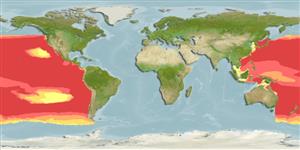>
Myctophiformes (Lanternfishes) >
Myctophidae (Lanternfishes) > Lampanyctinae
Etymology: Lampadena: Greek, lampas, -ados = torch + Greek, aden = gland (Ref. 45335).
Issue
Issue on validity of subspecies: subspecies considered as valid in FB, elevated to species rank as Lampadena urophaos Paxton, 1963 in Eschmeyer (CofF ver. Mar. 2011: Ref. 86697). Please send references, or more studies are needed.
Environment: milieu / climate zone / profondeur / distribution range
Écologie
marin pelagic-oceanic; profondeur 50 - 1047 m (Ref. 58302). Subtropical; 48°N -
Western Pacific: Suruga Bay, Japan and near the Ogasawara and Ryukyu islands. Also New South Wales, Australia (Ref. 7300) and New Zealand (Ref. 5755). Eastern Pacific: between 42°N and 25°N from the California coast to Hawaii (Ref. 4479). Recorded off British Columbia, Canada (Ref. 11980) and from Chile (Ref. 9068).
Taille / Poids / Âge
Maturité: Lm ? range ? - ? cm
Max length : 20.0 cm SL mâle / non sexé; (Ref. 123983)
Description synthétique
Clés d'identification | Morphologie | Morphométrie
Épines dorsales (Total) : 0; Rayons mous dorsaux (Total) : 14 - 16; Épines anales: 0; Rayons mous anaux: 13 - 14; Vertèbres: 35 - 38. Branchiostegal rays: 9-10 (Ref. 31442).
Body shape (shape guide): fusiform / normal.
Epipelagic to mesopelagic (Ref. 31442) at 50-600 m at night, 500-1000 m during day (Ref. 58302). Reported from depths of 100-500 m in Subarctic Pacific gyres (Ref. 51600). Oviparous, with planktonic eggs and larvae (Ref. 31442).
Life cycle and mating behavior
Maturité | Reproduction | Frai | Œufs | Fécondité | Larves
Paxton, J.R., D.F. Hoese, G.R. Allen and J.E. Hanley, 1989. Pisces. Petromyzontidae to Carangidae. Zoological Catalogue of Australia, Vol. 7. Australian Government Publishing Service, Canberra, 665 p. (Ref. 7300)
Statut dans la liste rouge de l'IUCN (Ref. 130435: Version 2025-1)
Menace pour l'homme
Harmless
Utilisations par l'homme
Outils
Articles particuliers
Télécharger en XML
Sources Internet
Estimates based on models
Preferred temperature (Réf.
123201): 3.1 - 19.2, mean 12 °C (based on 460 cells).
Phylogenetic diversity index (Réf.
82804): PD
50 = 0.5010 [Uniqueness, from 0.5 = low to 2.0 = high].
Bayesian length-weight: a=0.01023 (0.00404 - 0.02593), b=3.05 (2.83 - 3.27), in cm total length, based on LWR estimates for this (Sub)family-body shape (Ref.
93245).
Niveau trophique (Réf.
69278): 3.2 ±0.2 se; based on size and trophs of closest relatives
Résilience (Réf.
120179): Milieu, temps minimum de doublement de population : 1,4 à 4,4 années (Preliminary K or Fecundity.).
Fishing Vulnerability (Ref.
59153): Low vulnerability (14 of 100).
🛈
